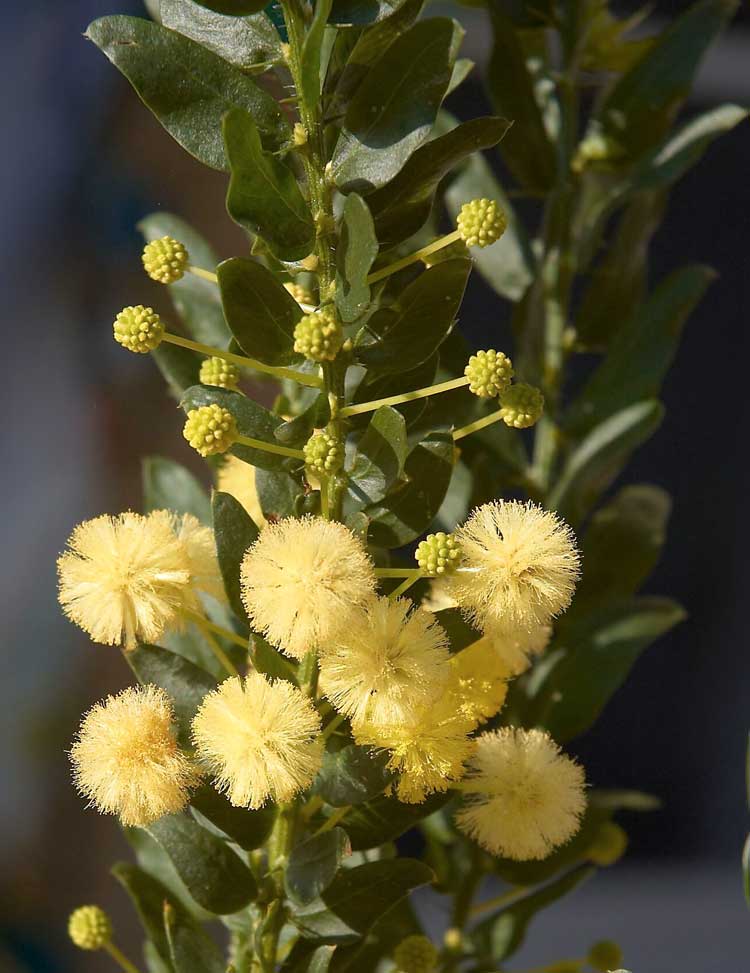
Acacia paradoxa (*)
Classification System: APG IV
Superregnum: Eukaryota
Regnum: Plantae
Cladus: Angiosperms
Cladus: Eudicots
Cladus: Core eudicots
Cladus: Rosids
Cladus: Eurosids I
Ordo: Fabales
Familia: Fabaceae
Subfamilia: Caesalpinioideae
Tribus: Acacieae
Genus: Acacia
Species: Acacia paradoxa
Name
Acacia paradoxa DC., 1813
Synonyms
Acacia armata R.Br.
Acacia armata var. angustifolia Benth.
Acacia armata var. longipedunculata Regel
Acacia armata var. microphylla Benth.
Acacia armata var. ornithophora (Sweet) Benth.
Acacia armata var. pendula Seem.
Acacia armata var. undulata(Siebert & Voss) Riebe
Acacia armatoides Walp.
Acacia falcifolia Hoffmanns.
Acacia furcifera Lindl.
Acacia ornithophora Sweet
Acacia undulata Spin
Acacia undulata Willd. ex Spreng.
Acacia undulata Willd. ex H.L.Wendl.
Acacia undulata var. elegans Jacques
Acacia undulata var. longispina Vis.
Mimosa paradoxa (DC.) Dum.Cours.
Phyllodoce armata (R.Br.) Link
Phyllodoce undulata Link
Racosperma armatum (R.Br.) Mart.
Racosperma paradoxum (DC.) Pedley
Racosperma undulatum Mart.
Homonyms
Acacia paradoxa Chiov. Senegalia hamulosa (Benth.) Boatwr.
Distribution
Native distribution areas:
Acacia paradoxa
Continental: Australasia
Regional: Australia
New South Wales, Queensland, South Australia, Victoria
Introduced into:
California, Cape Provinces, Chile Central, India, New Zealand North, New Zealand South, Northern Provinces, Palestine, Tasmania, Western Australia, Zaïre
References: Brummitt, R.K. 2001. TDWG – World Geographical Scheme for Recording Plant Distributions, 2nd Edition
References
Primary references
de Candolle, A.P. 1813. Catalogus plantarum Horti Botanici Monspeliensis. Monspelii: J. Martel. Parisiis et Argentorati: A. Koenig. Bibliotheca Digital Reference page. : 74.
Links
Govaerts, R. et al. 2020. Acacia paradoxa in Kew Science Plants of the World online. The Board of Trustees of the Royal Botanic Gardens, Kew. Published online. Accessed: 2020 Aug 10. Reference page.
International Plant Names Index. 2019. Acacia paradoxa. Published online. Accessed: Aug 10 2019.
Tropicos.org 2019. Acacia paradoxa. Missouri Botanical Garden. Published online. Accessed: 10 Aug 2019.
Catalogue of Life: 2021 Annual Checklist
Acacia paradoxa – Taxon details on World Wide Wattle.
USDA, ARS, Germplasm Resources Information Network. Acacia paradoxa in the Germplasm Resources Information Network (GRIN), U.S. Department of Agriculture Agricultural Research Service. Accessed: 09-Oct-10.
Vernacular names
English: Hedge Wattle, Kangaroo Acacia, Kangaroo Thorn, Prickly Wattle
suomi: Harja-akaasia
Acacia paradoxa[1] is a plant in the family Fabaceae. Its common names include kangaroo acacia,[2] kangaroo thorn, prickly wattle, hedge wattle[3] and paradox acacia.
Description
The large shrub or tree up to 2 to 4 metres (7 to 13 ft) tall[4] and has a similar width,[3] it has ribbed branchlets that are often arched downward. It is dense with foliage; the leaves are actually enlarged petioles known as phyllodes. They are crinkly and the new ones are covered in hairs. The erect phyllodes are asymettric and have a lanceolate shape and are around 30 millimetres (1.18 in) in length and 7 mm (0.276 in) wide.[4] The bush is also full of long spines. It usually flowers between August and November[3] producing an axillary flower-spike with small, bright yellow spherical flower heads and the fruits are brown pods 4 to 7 centimetres (1.6 to 2.8 in) long. The hard black seeds within have an oblong shape and are about 6 mm (0.236 in) in length and half as wide.[4]
The spiny stipules that grow at the base of the phyllodes deter livestock from feeding on or too close to the plant.
Taxonomy
The species was first formally described by the botanist Augustin Pyramus de Candolle in 1813 as part of the work Catalogus Plantarum Horti Botanici Monspeliensis.[2] The species name is from the Greek words para which means near and doxa meaning glory. This probably refers the unattractive and thorny shrub being quite showy when it is in bloom.[4]
Many synonyms are known for the plant including; Acacia ornithophora, Acacia undulata, Mimosa paradoxa, Racosperma paradoxum, Acacia armata and Acacia hybrida.[2]
Distribution
Kangaroo thorn is widely spread across Australia, regenerating from seed after disturbances, such as bush fire. Small birds, including wrens, use this plant as shelter and dwelling, while it is relied upon as a food source for moths, butterflies and other insects, birds also feed on its seeds.
It is endemic to south eastern parts of South Australia, much of Victoria, eastern New South Wales and south eastern parts of Queensland.[2] It has become naturalised in parts of Western Australia and Tasmania.[4]
The plant has also been introduced to other continents. In the United States, kangaroo thorn is a well-known noxious weed in California.[5]
Cultivation
The plant is used as an ornamental or as a dense screening plant. It make an excellent habitat and food source for birds. It grows well in full sun or in a partly shaded position. It can be planted in dry to moist well-drained areas.[3] Seeds require pre-treatment such as scarification prior to planting.[4]
References
"Acacia paradoxa". Australian Plant Name Index (APNI), IBIS database. Centre for Plant Biodiversity Research, Australian Government, Canberra. Retrieved 2008-04-03.
"Acacia paradoxa DC. Kangaroo Acacia". Atals of Living Australia. Global Biodiversity Information Facility. Archived from the original on 26 November 2018. Retrieved 3 October 2018.
"Acacia paradoxa". Yarra Ranges. Archived from the original on 1 March 2020. Retrieved 3 October 2018.
"Acacia paradoxa (Leguminosae) Kangaroo Thorn". Seeds of South Australia. Government of South Australia. Retrieved 3 October 2018.
"Acacia paradoxa". Plants Profile. United States Department of Agriculture. Retrieved 2 April 2012.
Further reading
Zenni, R. D.; Wilson, J. R. U.; Le Roux, J. J.; Richardson, D. M. (August 2009). "Evaluating the invasiveness of Acacia paradoxa in South Africa". South African Journal of Botany. 75 (3): 485–496. doi:10.1016/j.sajb.2009.04.001.
Correia, Marta; Castro, Silvia; Ferrero, Victoria (April 2014). "Reproductive biology and success of invasive Australian acacias in Portugal". Botanical Journal of the Linnean Society. 174 (4): 574–588. doi:10.1111/boj.12155. Retrieved 30 April 2015.
Castro-Diez, P.; Langendoen, T.; Poorter, L. (1 November 2011). "Predicting Acacia invasive success in South Africa on the basis of functional traits, native climatic niche and human use". Biodiversity and Conservation. 20 (12): 2729–2743. doi:10.1007/s10531-011-0101-5. S2CID 41606801.
Retrieved from "http://en.wikipedia.org/"
All text is available under the terms of the GNU Free Documentation License

